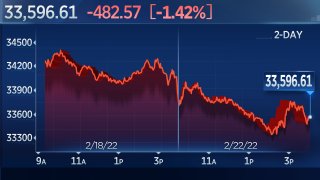
The S&P 500 closed in correction territory on Tuesday, as intensifying tensions between Russia and Ukraine dented market sentiment to start the week.
The Dow Jones Industrial Average dropped 482.57 points to 33,596.61, dragged down by an 8.9% loss in Home Depot. The Dow fell for its fourth straight session. The S&P 500 fell 1% to 4,304.76 and closed more than 10% from its record close, a technical correction. The Nasdaq Composite slipped 1.2% to 13,381.52. The U.S. stock market was closed Monday due to the Presidents' Day holiday.
The major averages pared losses late in the trading day, however. At its session low, the Dow had lost more than 700 points.
Get Southern California news, weather forecasts and entertainment stories to your inbox. Sign up for NBC LA newsletters.
President Joe Biden on Tuesday announced sanctions on Russian bank VEB and its military bank, Russia's sovereign debt and certain wealthy individuals and their families. The U.K. has also started targeted economic sanctions against five Russian banks and three wealthy individuals.
That move came a day after Russian President Vladimir Putin said he would recognize the independence of two breakaway regions in Ukraine, potentially undercutting peace talks with Biden. Putin also ordered forces into the two breakaway regions.
"The Russia/Ukraine situation remains very fluid, and tensions remain high, and in the short term that will remain a headwind on stocks," said Tom Essaye, founder of the Sevens Report.
Money Report
On Sunday, the White House said that Biden has accepted "in principle" to meet with Putin in yet another effort to deescalate the Russia-Ukraine situation via diplomacy. White House press secretary Jen Psaki said the summit between the two leaders would occur after a meeting between Secretary of State Antony Blinken and his Russian counterpart Sergey Lavrov.
The VanEck Russia ETF, a U.S.-traded security which invests in top Russian companies, dropped 8.9% on Tuesday.
Oil prices rose, with West Texas Intermediate futures jumping 1.5% to $92.27 per barrel.
The Russia-Ukraine conflict has put pressure on market sentiment recently, with the major averages coming off of back-to-back weekly losses. The Dow fell 1.9% last week, and the S&P 500 and Nasdaq Composite slid 1.6% and 1.8%, respectively.
Anxieties over the Federal Reserve's move to raise interest rates – particularly the prospect of a half-point rate hike – have pushed stocks lower in recent weeks. However, the latest escalation in the Russia-Ukraine conflict ultimately threw the S&P 500 into correction territory.
"While Monday's episode will have important implications for Russia's political relations with foreign partners, a significant market event is likely avoided for the time being, but the trajectory in the coming weeks will be important to monitor from a rising market risk perspective," said Ed Mills of Raymond James.
Earnings and data
Home Depot reported a quarterly profit of $3.21 a share, three cents better than estimates, and said it sees earnings and revenue growth this year. Shares, however, fell nearly 9%.
Meanwhile, Macy's dropped 5% despite beating on the top and bottom lines of its quarterly results. Macy's also authorized a new $2 billion share buyback program and announced a 5% dividend increase.
In deal news, Houghton Mifflin Harcourt shares surged about 15.3% after the company said it would be taken private by Veritas Capital in a deal worth $21 a share, representing a nearly 16% premium from Friday's close. The deal is expected to be completed in the second quarter.
On the economic data front, the IHS Markit manufacturing PMI rose to 52.5 in February from 50.5. The IHS Markit services PMI jumped to 56 in February from 51.1 the month prior.
Traders are also keeping an eye on the Federal Reserve, as the U.S. central bank is expected to raise rates multiple times starting next month. Traders are betting that there is a 100% chance of a Fed rate hike after the March 15-16 meeting, with expectations tilting toward a 0.25 percentage point move, according to the CME Group's FedWatch tool.
Expectations of tighter monetary policy have put pressure on stocks, particularly those in rate-sensitive sectors like tech, and have sent Treasury yield sharply higher to start 2022. The benchmark 10-year Treasury yield ended last week around 1.93% after briefly breaking above 2%. The 10-year began 2022 trading at around 1.51%.






